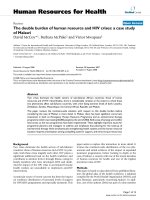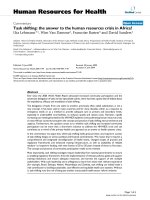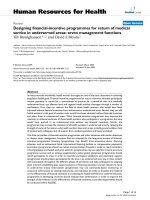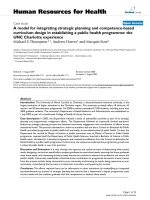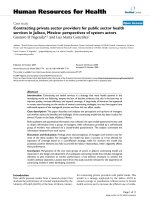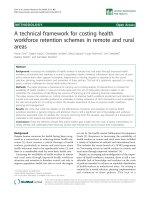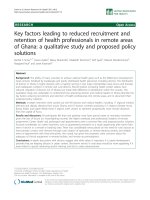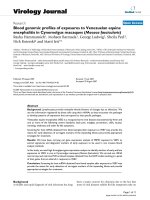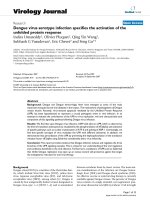Báo cáo sinh học: " Liver-spleen axis, insulin-like growth factor-(IGF)-I axis and fat mass in overweight/obese females" pot
Bạn đang xem bản rút gọn của tài liệu. Xem và tải ngay bản đầy đủ của tài liệu tại đây (289.14 KB, 8 trang )
RESEARCH Open Access
Liver-spleen axis, insulin-like growth factor-(IGF)-I
axis and fat mass in overweight/obese females
Silvia Savastano
1*
, Carolina Di Somma
2
, Genoveffa Pizza
1
, Annalba De Rosa
1
, Valeria Nedi
1
, Annalisa Rossi
1
,
Francesco Orio
3
, Gaetano Lombardi
1
, Annamaria Colao
1
and Giovanni Tarantino
4
Abstract
Background: Fat mass (FM) in overweight/obese subjects has a primary role in determining low-grade chronic
inflammation and, in turn, insulin resistance (IR) and ectopic lipid storage within the liver. Obesity, aging, and FM
influence the growth hormone/insulin-like growth factor (IGF)-I axis, and chronic inflammation might reduce IGF-I
signaling. Altered IGF-I axis is frequently observed in patients with Hepatic steatosis (HS). We tested the hypothesis
that FM, or spleen volume and C-reactive protein (CRP)–all indexes of chronic inflammation – could affect the IGF-I
axis status in overweight/obese, independently of HS.
Methods: The study population included 48 overweight/obese women (age 41 ± 13 years; BMI: 35.8 ± 5.8 kg/m
2
;
range: 25.3-53.7), who underwent assessment of fasting plasma glucose and insulin, homeostasis model assessment
of insulin resistance (HOMA), cholesterol and triglycerides, HDL-cholesterol, transaminases, high-sensitive CRP, uric
acid, IGF-I, IGF binding protein (BP)-1, IGFBP-3, and IGF-I/IGFBP-3 ratio. Standard deviation score of IGF-I according
to age (zSDS) were also calculated. FM was determined by bioelectrical impedance analysis. HS severity grading
(score 0-4 according liver hyperechogenicity) and spleen longitudinal diameter (SLD) were evaluated by ultrasound.
Results: Metabolic syndrome (MS) and HS were present in 33% and 85% of subjects, respectively. MS prevalence
was 43% in subjects with increased SLD. IGF-I values, but not IGF-I zSDS, and IGF-I/IGFBP-3 ratio were significantly
lower, while FM%, FPI, HOMA, ALT, CRP, were significantly higher in patients with severe HS than in those with
mild HS. IGF-I zSDS (r = -0.42, r = -0.54, respectively; p < 0.05), and IGFBP-1 (r = -0.38, r = -0.42, respectively; p <
0.05) correlated negatively with HS severity and FM%. IGF-I/IGFBP-3 ratio correlated negatively with CRP, HS
severity, and SLD (r = -0.30, r = -0.33, r = -0.43, respectively; p < 0.05). At multivariate analysis the best
determinants of IGF-I were FM% (b = -0.49; p = 0.001) and IGFBP -1 (b = -0.32; p = 0.05), while SLD was in the IGF-
I/IGFBP-3 ratio (b = -0.43; p = 0.004).
Conclusions: The present study suggests that lower IGF-I status in our study population is associated with higher
FM, SLD, CRP and more severe HS.
Background
Adipose tissue produces a large number of inflammatory
molecules responsible for low-grade chronic inflamma-
tion and insulin resistance (IR) [1]. In obese non-dia-
betic adults, the prevalence of nonal coholic fatty liver
disease (NAFLD) or, generally speaking, hepatic steatosis
(HS), is high and is considered a further expression of
metabolic syndrome (MS) [2]. Ultrasound (US) is widely
used to detect HS [3] with high specificity, although it
underestimates the prevalence of HS when there is <
20% fat [4]. Tsushima et al. first emphasized the role of
the spleen in NAFLD patients [5]. It has been recently
proposed that increased spleen volume–a stable index of
chronic inflammation and activation of the immune sys-
tem, and elevated concentrations of high sensitivity (hs)-
CRP, both characterize young adult obese subjects with
HS [6], just as high IL-6 levels coupled w ith larger
spleen is suggestive of severe HS [7].
Up to 90% circulating insulin-like growth factor (IGF)-
I, the main anabolic effector of Growth hormone (GH),
originates in the liver, and hepatocytes represent also
* Correspondence:
1
Department of Molecular and Clinical Endocrinology and Oncology,
Division of Endocrinology; Federico II University Medical School, Via S.
Pansini 5-80131 Naples-Italy
Full list of author information is available at the end of the article
Savastano et al. Journal of Translational Medicine 2011, 9:136
/>© 2011 Savastano et al; licensee BioMed Central Ltd. This is an Open Access article distributed under the terms of the Creative
Commons Attribut ion License (http://creativecommon s.org/licenses/by/2.0), whi ch permits unrestricted use, distribution, and
reproduction in any medium, provided the original work is properly cited.
the largest source of IGF-binding protein (BP)-1 and
IGFBP-3, the main IGF-I plasma carriers that regulate
IGF-I bioavailability [8]. However, aging and a number
of inflammatory cytokines are al so known to affect IGF-
I secretion from hepatocytes [9]. A number of clinical
investigations have evalua ted the interaction between
HS [10], inflammation [11], and the IGF-I pathway;
however, considering the effect of aging on IGF-I status
and the role of IGF-I axis on body composition [12], no
evidence of an association between HS, age-corrected
IGF-I values, anthropometric data and spleen enlarge-
ment has been produced. Thus, we tested the hypothesis
that the obesity-related low-grade chronic inflammation,
evaluated by spleen volume and C-reactive protein
(CRP), could affect the IGF-I axis sta tus in overweight/
obese, independently of HS.
Patients and Methods
Subjects
One hundred and thirteen overweight/obese women
were consecutively selected to enter this study. They
were referred to our Departments from October 1
st
,
2008 to July 31
st
, 2009 t o participate in a weight loss
program and/or to be evaluated as bariatric surgery can-
didates. In particular, female gender and age range were
introduced as inclusi on criteria to minimize the con-
founding effects of aging and sex-steroids on IGF-I
metabolism [8]. Patients were on mild hypocaloric diet
and reported exercising regularly 3 h/week. None of
them had taken weight loss drugs or dietary supple-
ments for a t least three weeks before enrolment. The
final population included 48 i ndividuals–14 of whom in
the post-menopausal status, mean age and BMI of 41 ±
13 years and 35.8 ± 5.8 Kkg/m
2
(range 25.3-53.7; 7 5
percentile 38.8 <; 95 5 CI 37.140.9).
Exclusion criteria
i) Absence of T2D; paras itic infestations, microcythemia;
chronic liver diseases of viral, alcoholic or autoimmune
nature, or advanced NAFLD characterized by liver fibro-
sis; renal failure; cancer and acute viral, bacterial or fun-
gal infection; the presence/absence of the above
conditions was deter mined by complete medical exami-
nat ions and/or laborator y investigations aimed at evalu-
ating serum HCV-RNA, serum HBV-DNA; alcoholism
at random, MCV, serum ferritin; serum ANA and
AMA; AST/platelet ratio index; serum uric acid and
creatinine; neoplastic markers; biological liquid culture;
ii) absence of any other pituitary deficiency [13].
Out of 113 initial patients selected, we excluded eight
patients who were older than 65 years; ten who were on
metformin, nine on statins and/or clofibrate and seven
on l evothyroxine. In addition, 12 patients were excluded
because they were being treated with low-doses of
aspirin, two who were on hormone replacement therapy,
fourteen who had joined previous weight loss programs
and three who suffered from arthritis, bronchial asthma
and chronic inflammatory bowel.
Study design
This prospective study was conducted in accordance
with the guidelines of the Declaration of Helsinki. The
study was approved by the Ethics Committee of the
Federico II University Medical School of Naples, (#231/
05, February 20, 2006). All participants gave written
consent. The primary outcome measures were the sono-
graphic quantification of HS and spleen longitudinal
diameter (SLD) at US, in addition to BMI, waist circum-
ference, FM, IGF-I, IGFBP-1, IGFBP-3, IGF-I/IGFBP-3
ratio measurements. Secondary outcome measures were
homeostasis model assessment of insulin resistance
(HOMA), cholesterol and triglycerides, HDL-cholesterol,
transaminases, CRP, and serum uric acid (UA).
Laboratory data
All biochemical analyses including fasting plasma glu-
cose (FPG), total cholesterol, HDL cholesterol, LDL cho-
lesterol, triglycerides, transaminases, and uric acid were
performed with a Roche Modular Analytics System in
the Central Biochemistry Laboratory of our Institution.
LDL and HDL cholesterol were determined by direct
method (homogeneous enzymatic assay for the direct
quantitative determination of LDL and HDL choles-
terol). QC was performed with Bio-Rad’ sQualityCon-
trol Products. , CRPwas measured using commercially
available assays. T2D was defined as fasting blood glu-
cose levels ≥ 126 mg/dL on two separate determina-
tions, while Impaired Fasting Glucose (IFG) was defined
as fasting blood glucose levels ≥ 110 < 126 mg/dL [14].
MS was diagnosed according to the revised Adults
Treatment Panel III (2001), and three or m ore of the
diagnostic criteria considered were: plasma glucose con-
centration of at least 100 mg/dL, waist circumference
(WC) > 88 cm, serum HDL concentration < 50 mg/dL,
blood pressure of at least 130/85 mmHg, and serum tr i-
glyceride concentrations o f at least 150 mg/dL [15].
Fasting plasma insulin (FPI) was measured by a solid-
phase chemiluminescent enzyme immunoassay using
commercially available kits (Immulite 2000; Diagnostic
Produ cts Co, Los Angeles, CA, USA), the upper limit of
the normal range being 15.6 μU/mL. HOMA was calcu-
lated according to Matthews et al [16]. As a stringent
measure of IR, a value of HOMA > 2 was introduced
[16]. Serum IGF-I levels were measured by IRMA after
ethanol extraction using Diagnostic System Laboratori es
Inc. (Webster, Texas, USA). The sensitivity of the assay
was 0.8 μg/L; the normal ranges in adults aged 20-40
and 41-60 years were 110-494 and 100-300 μg/l,
Savastano et al. Journal of Translational Medicine 2011, 9:136
/>Page 2 of 8
respectively. The intra-assay CVs were 3.4, 3.0, and 1.5%
for low, medium, and high points on the standard curve,
respectively; inter-assay CVs were 8.2, 1.5, and 3.7% for
low, medium, and high points on the standard curve,
respectively. IGFBP-1 andIGFBP-3levelsweremea-
sured by ELISA (DSL Inc, Webster, TX). IGFBP-1 assay
had a sensitivity of 0.25 ng/l; the intra and inter-assay
coefficients of variation were 1.7-4.6% and 6.2-7.6%,
respectively; the normal range for an adult female popu-
lationinthesameagerangeasourstudypopulationis
2670-5580 ng/ml. IGFBP-3 assay had a sensitivity of
0.04 ng/l; the intra and inter-assay coefficients of varia-
tion were 1.8-3.9% and 0.6-1.9%, respectively; the nor-
mal range for an adult female population in the same
age range as our study population is 2670-5580 ng/ml.
IGF-I/IGFBP-3 ratio was calculated as a indirect mea-
sure of free IGF-I. The values for the molecular mass of
IGF-I and IGFBP-3 used for the calculation were 7.649
kDa and 28.5 kDa, respectively [17].
Anthropometric evaluation
Obesity-related anthropometric measurements were
made with the patients wearing only light underclothing
and no shoes. Body weight was determined to the near-
est 50 g using a calibrated balance beam scale. Body
massIndex(BMI)wascalculatedasweight(kg)divided
by height squared (m
2
) and used as a n index of obes ity.
Subjects were classified as overweight or obese on the
basis of BMI cut-off points of ≥ 25 .0 and ≤ 29.9 kg/m
2
,
respectively. WC was measured at the mid-point
between the umbilicus and the x iphoid. In pre-meno-
pausal women, the data were obtained during the early
follicular phase, 5-7 days after spontaneous menses.
Biompedance analysis
Body composition was determined by conventional bioe-
lectrical impedance analysis and by bioel ectrical impe-
dance vector analysis with a single-frequency 50-kHz
bioelectrical impedance analyzer (BIA 101 RJL, Akern
Bioresearch, Florence, Italy), according to the standard
tetrapolar techniq ue, and employing the sof tware pro-
vided by the manufacturer [18]. Patients were evaluated
for FM% after an overnight fast and were asked to
refrain from strenuous exercise and to maintain their
usual intake of caffeinated beverages during the 3 days
preceding the measurements.
Ultrasound analyses
Sonographic measurements were performed by the same
operator, blinded to patients’ data , using a Vivid system
(General Electric Healthcare Company, Milan, Italy ).
Briefly, SLD, the best single measurement well related to
spleen size, was measured by postero-lateral scanning.
Maximum and cranio-caudal lengths were measured
andthenaveraged.AcutoffforLSDwassetat103
mm [7]. The classification of “bright liver” or HS sever-
ity was based on the following scale of hyper-echogenity:
0 = absent, 1 = light, 2 = moderate, 3 = severe, pointing
out the difference between the densities of the liver and
the right kidney [19]. Technical ly, echo intensity can be
influenced by many factors, particularly b y gain inten-
sity. To avoid confounders that could modify echo
intensity and thus bias the comparisons, the mean
brightness levels of both liver and right kidney cortex
were obtained on the same longitudinal sonographic
plane. The levels of b rightness of liver and right kidney
were calculated three times directly from the frozen
images.
Non-invasive liver fibrosis assessment
The aspartate aminotransferase (AST)/platelet ratio index
was calculated as follows: AST level (U/L)/Upper normal
limit for AST (35 U/L)/Platelet count (10/L) × 100.
Statistical Analysis
Data were expressed as Mean ± SD. Since IGF-I is
related to age, to analyze the relationships between IGF-
I levels and the other variables, we calculated the stan-
dard deviation score (SDS) of IGF-I levels according to
age (zSDS). To this aim, we calculated the mean and SD
of IGF-I levels in adults (21-40 years) and middle-aged
(41-65 years) women [20]. Differences in variables
between groups according to HS classification were ana-
lyzed u sing ANOVA with the Bonferroni post-hoc test.
Pearson’s r or Spearman rho coefficients tests were used
to analyze the association between variables when
opp ortune. AST variable was log transformed. The pre-
sence of independent and significant associations
between MS and SLD (< or > 103 mm) in the study
groups was analyzed u sing multiple logistic regression,
calculating the odds ratio (OR) and 95% confidence
interval (CI). Using IGF-I, IGFBP-1, and IGF-I/IGFBP-3
ratio as dependent variables, three multiple linear
regression analysis models were performed with the
enter selection methods to evaluate the relative impor-
tance of HS score and FM% on IGF-I and IGFBP-1,
respectively, and of CRP, HS score, transaminases, and
SLD on IGF-I/IGFBP-3 ratio. To determine which vari-
ables contributed more or less to the regression equa-
tion, the standardized regression coefficient, or beta, and
its ratio to the respective SE, i.e., the t-test, were calcu-
lated. To avoid multicol linearity, i.e., situations i n which
the predictors are correlated to each other to some
degree, the variance inflation factor and tolerance were
setat>10and<0.1,respectively.Pvalues<0.05were
considered statistically significant. The concordance
correlation coefficient (r
c
), which measures precision
and accuracy, was adopted to evaluate the degree of
Savastano et al. Journal of Translational Medicine 2011, 9:136
/>Page 3 of 8
intra-observer variation at US. Data were stored and
analyzed using IBM SPSS Statistics 18.0 (SPSS Statistics,
Chicago, IL, USA) and MedCalc
®
package.
Results
The concordance correlation coefficient to evaluate the
degree of intra-operator variation at US for HS detec-
tion and spleen measurements was high (r
c
= 0.91). To
rule out any interference of estrogens, data were ana-
lyzed grouping overweight/obese women according to
menopausal status (table 1). Although there was a trend
for higher FM% (p = 0.09) and systolic blood pressure
(p = 0.06) among menopausal women, there were no
significant differences in any of the variables between
pre and postmenopausal subjects.
MS, HS, IFG were present in 33% (16), 85% (41), and
8% (4) of subjects, respectively. According to HS results,
7 subjects achieved a score of 0; 14 a score of 1 and 2;
13 a score of 3. The AST/platelet ratio index was higher,
albeit not significantly, in HS scores 2-3. Table 2 shows
the data obtained grouping subjects with HS scores of
0-1 and 2-3. IGF-I values, but not IGF-I zSDS, and IGF-
I/IGFBP-3 ratio were significantly lower, whil e FM%,
FPI, HOMA, alanine aminotransferase (ALT), CRP, were
higher in patients with HS scores 2-3 than in those who
had scored 0-1. According to cut off of 103 mm for
SLD, MS prevalence was 43% in subjects with SLD >
103 mm, and 1% in subjects with SLD < 103 mm ( c
2
=
4.2; p = 0.04); thu s, the likelihood of having MS was
highest in the SLD > 103 mm subgroup (OR: 7.5; 95%
CI 0.86 to 65.2).
Correlations between the study variables are reported
in Table 3. As expected, BMI correlated positively with
HOMA and HS severity, whereas transaminase levels
correlated positively with HS se verity; moreover, a posi -
tive correlation was also evident between BMI and SLD,
Table 1 Obesity-related anthropometric measurements and metabolic components in moderately-severely obese
females, grouped according to menopausal status
Study
group
Pre-menopause Post-menopause Normal
values/
Range
p
values
Subjects n.48 n. 34 n. 14
BMI 35.5 ± 6.2 35.4 ± 6.8 35.6 ± 4.5 / NS
Waist circumference 110.8 ± 15.9 110.1 ± 16.5 112.6 ± 14.6 < 88 cm NS
Fat mass % 40.1 ± 7.2 39.2 ± 8.8 42.2 ± 4.7 16-30% NS
FPG 92.4 ± 11.5 91.1 ± 11.4 95.8 ± 11.6 60-110 mg/dl NS
FPI 14.4 ± 9.2 14.4 ± 9.0 14.1 ± 10.2 1-20 μU/ml NS
HOMA 3.3 ± 2.2 3.3 ± 2.1 3.5 ± 2.8 ≤ 2.5 NS
Total cholesterol 198.1 ± 33.2 192.6 ± 30.4 211.5 ± 37.3 ≤ 190 mg/dl NS
HDL cholesterol 52.3 ± 21.3 54.4 ± 24.7 50.3 ± 7.6 ≥ 45 mg/dl NS
Triglycerides 124.5.8 ± 72.2 121.6.8 ± 62.1 142.0 ± 81.9 ≤ 150 mg/dl NS
SBP 129.4 ± 17.8 126.3 ± 14.7 136.7 ± 22.4 ≤ 120 mmHg NS
DBP 84.1 ± 10.8 83.4 ± 10.2 89.3 ± 11.9 ≤ 80 mmHg NS
AST 23.6 ± 14 18.9 ± 3.8 24.3 ± 14.5 < 35 U/L NS
ALT 32.5 ± 31.3 33.8 ± 32.6 23.3 ± 6.9 < 35 U/L NS
Uric acid 4.5 ± 1.2 4.4 ± 1.0 4.6 ± 09 2.4-5.7 mg/dl NS
CRP 2.9 ± 2.7 3.2 ± 2.5 2.4 ± 2.1 ≤ 1.6 mg/dl NS
SLD 112.9 ± 12.9 112.9 ± 12.9 109.5 ± 12.2 ≤ 110 mm NS
IGF-I 167.8 ± 80.2 175.5 ± 91.5 148.4 ± 36.5 100-494 μg/l NS
IGF-I zSDS -1.9 ± 1.7 -1.9 ± 2.0 -2.0 ± 1.0 / NS
IGFBP-1 18.8 ± 14.5 19.4 ± 15.8 17.5 ± 12.6 / NS
IGFBP-3 4445.4 ± 1331.1 4478.8 ± 1290.5 4369.3 ± 1467.2 2670-5580 ng/ml NS
IGF-I/IGFBP3 0.027 ± 0. 01 0.027 ± 0. 01 0.028 ± 0.01 / NS
AST/platelet index ratio 0.45 ± 4.7 0.44 ± 4.2 0.48 ± 5.6 < 0.76 NS
Hepatic steatosis 41 29 12 / NS
Data are reported as mean ± SD. FPG, fasting plasma glucose; FPI, fasting plasma insulin; HOMA, homeostasis model assessment of insulin resistance; SBP, systolic
blood pressure; DBP, diastolic blood pressure; AST, aspartate aminotransferase; ALT, alanine aminotranferase; CRP, C-reactive protein; SLD, spleen longitudinal
diameter; IGF-I, Insulin-like growth factor-I; IGF-I zSDS, SDS of IGF-I levels according to age; IGFBP-1, IGF-binding protein-1; IGFBP-3, IGF-binding protein-3; IGF-I/
IGFBP-3, IGF-I/IGFBP-3 ratio.
Savastano et al. Journal of Translational Medicine 2011, 9:136
/>Page 4 of 8
and/or between transaminases and UA. FM% also corre-
lated positively with HOMA and HS severity.
IGF-I zSDS and IGFBP-1 correlated negatively with
FM% and HS severity at US (Figure 1a, b, c, and 1d).
Similarly, IGF-I/IGFBP-3 ratio correlated negatively with
CRP, HS severity, and also SLD; vice versa, AST was not
significantly associated with these variables (Figure 2a,
b, d, and 2c). WC did not correlate with IGF-I levels
(r = 0.12, p = 0.93).
At multivariate analysis the highest values of FM%
well predicted the lowest levels of both IGF-I (b = -0.49;
t = -3.67; p = 0.001) and IGFBP-1 (b = -0.32; t = -2.07;
p = 0.05) , where as SLD was the best determinant of the
IGF-I/IGFBP-3 ratio (b = -0.43; t = -3.04; p = 0.004),
since a major spleen enlargem ent was associated with a
lower IGF-I/IGFBP-3 ratio.
Discussion
The re sults of this study underline that spleen enlarge-
ment, a parameter expressing low-grade chronic inflam-
matory status, was a major determinant of low IGF-I/
IGFBP-3 ratio than HS per se.Wealsofoundasignifi-
cant negative correlation betwee n all the components of
the IGF-I axis investigated and F M%, HOMA, or HS
severity. However, FM%. was a better determinant of
IGF-I and IGFBP-1 than HS per se inthesamepopula-
tion. To the best of our knowledge, these associations
are novel, and might contribute t o the understanding of
the involvement of the liver-spleen axis and FM in the
pathogenesis of low IGF-I status in obesity.
Previous results evidenced the association of low IGF-I
levels and IGF-I/IGFBP-3 ratio with different degrees of
hyperechogenic liver pattern [10]. To this regard, the
present study adds new information on this association
as it shows the relevant role of SLD, and extends the
investigation to other components of the IGF-I axis,
such as IGFBP-1, an emerging marker of HS severity in
clinical situations [20], as is the case of IR [21]. Further-
more, to minimize the confounding effects of age and
gender, we calculated SDS of IGF-I values according
to age and included only overweight/ob ese women.
Table 2 Obesity-related anthropometric measurements
and metabolic components in moderately-severely obese
females, grouped according to hepatic steatosis score at
ultrasound (US) and in normal-weight controls matched
for age and sex
Hepatic steatosis score at US p values
0-1 score
(21/48)
2-3 grade
(27/48)
Age(years) 40.6 ± 14.7 40.6 ± 12.3 NS
BMI 32.7 ± 5.8 37.4 ± 5.8 NS
Waist circumference(cm) 107.8 ± 17.3 113.0 ± 14.9 NS
Fat mass % 35.7 ± 8.0 43.6 ± 6.0 < 0.001
FPG (mg/dl) 92.8 ± 14.2 92.5 ± 8.4 NS
FPI (μU/ml) 10.7 ± 5.3 17.6 ± 10.7 0.021
HOMA 2.5 ± 1.5 4 ± 2.5 0.037
Total cholesterol (mg/dl) 197.0 ± 30.9 201.9 ± 33.3 NS
HDL- cholesterol (mg/dl) 58.2 ± 29 49.8 ± 9.3 NS
Triglycerides (mg/dl) 111.7 ± 60.8 137.8 ± 81 NS
SBP (mmHg) 129.5 ± 17.2 130.4 ± 18.0 NS
DBP (mmHg) 84.6 ± 8.7 84.5 ± 11.5 NS
AST (U/L) 21.6 ± 6.0 26.2 ± 18.5 NS
ALT (U/L) 25.2 ± 10.8 49.9 ± 21.6 0.045
Uric acid (mg/dl) 4.4 ± 1.0 4.5 ± 1.1 NS
CRP (mg/dl) 1.9 ± 2.1 3.6 ± 3.0 0.04
SLD (mm) 108.5 ± 10.5 124.2 ± 13.7 0.004
AST/platelet ratio index 0.44 ± 3.2 0.47 ± 2.5 NS
IGF-I (μg/l) 203.8 ± 94.8 138.0 ± 54.0 0.004
IGF-I zSDS -1.2 ± 1.8 -2.5 ± 1.5 0.08
IGFBP-1 16.0 ± 3.7 12.8 ± 2.5 0.03
IGFBP-3 (ng/ml) 4526.8 ± 1321.8 4311.5 ± 1325.8 NS
IGF-I/IGFBP3 ratio 0.032 ± 0.01 0.023 ± 0.01 0.002
Data are reported as mean ± SD. FPG, fasting plasma glucose; FPI, fasting
plasma insulin; HOMA, homeostasis model assessment of insulin res istance;
SBP, systolic blood pressure; DBP, diastolic blood pressure; AST, aspartate
aminotransferase ; ALT, alanine aminotranferase; CRP, C-reactive protein; SLD,
spleen longitudinal diameter; IGF-I, Insulin-like growth factor-I; IGF-I zSDS, SDS
of IGF-I levels according to age; IGFBP-1, IGF-binding protein-1; IGFBP-3, IGF-
binding protein-3; IGF-I/IGFBP-3, IGF-I/IGFBP-3 ratio.
Table 3 Correlations between obesity-related anthropometric measurements and metabolic components in
moderately-severely obese females
BMI p HOMA p HS p ALT p AST p SLD p
BMI / 0.45 < 0.001 0.28 0.05 -0.38 0.01 0.46 0.001
HOMA 0.45 < 0.001 / 0.41 0.01 0.40 0.02
HS 0.28 0.05 0.34 0.04 / 0.30 0.05 0.31 0.05
CRP 0.31 0.034 0.28 0.05 0.33 0.04 0.69 < 0.001
Uric acid 0.51 0.001 0.40 0.02 0.355 0.02
FM% 0.50 < 0.001 0.35 0.034 0.50 < 0.001 0.33 0.03
HOMA, homeostasis model assessment of insulin resistance; HS, hepatic steatosis; AST, aspartate aminotransferase; ALT, alanine aminotransferase; CRP, C-reactive
protein; FM%, Fat Mass percentage.
Savastano et al. Journal of Translational Medicine 2011, 9:136
/>Page 5 of 8
Alterations in the activity of the GH-IGF-I axis, as well as
in inflammatory processes [22], seem to be related to
aging [23] and obesity [24]. As a matter of fact, we found
that the relationship between IGF-I and HS is likely to
become less evident when IGF-I is corrected for age.
Nevertheless, when the relationship between GH/IGF-I
status and FM was evaluated in the setting of severe obe-
sity, this association was independent of age [25].
In this context FM, SLD increase, HS grade, and the
impairment of the I GF-I axis might represent different
aspects of the same process, i.e., the chronic inflamma-
tion status, as an examp le of the maladaptation of obe-
sity and obesity-related metabolic disorders.
We need to be aware of limitations in interpreting the
results of this study. Firstly, the cross-sectional study
desi gn does not evidence a causal relationship s between
the study variables. Secondly, the data were obtained
from a h omogeneous and motivated group of women
and, therefore, cannot be generalized beyond the cases
studied, whereas the exclusion of patients with T2DM
could have limited the adequate assessment of MS pre-
valence. Thirdly, FM was e valuated by bioimpedance
analysis, which is useful for large-scale studies but is not
interchangeable with DEXA and should be interpreted
with caution, although recent evidence testifies in favor
of its interchangeability in the obesity setting [ 26].
Fourthly, liver and spleen have been assessed by US
parameters, which are operator-dependent; in this study
liver histology was not performed for ethical reasons,
and the use Fibroscan is not advisable in this type of
c
d
0 1 2 3
3
2
1
0
-1
-2
-3
-4
-5
HS score
IGF1 zSDS
ba
0,0 0,5 1,0 1,5 2,0 2,5 3,0
70
60
50
40
30
20
10
0
HS score
IGFBP1
r= -0.376
p=0.011
20 30 40 50 60
70
60
50
40
30
20
10
0
-10
FM%
IGFBP1
r= -0.416
p=0.04
20 30 40 50 60
-6
-5
-4
-3
-2
-1
0
1
2
3
FM%
IGFI z SDS
IGF-I zSDS
IGF-I zSDSIGFBP-1
IGFBP-1
HS score FM%
HS score
FM%
r= -0.417
p=0.003
r= -0.540
p<0.001
Figure 1 Correlation between IGF-I zSDS (a and b) and IGFBP-1 (c and d), with HS score at ultrasound (US), and FM%. IGF-I zSDS,
standard deviation score (SDS) of insulin-like growth factor-I levels according to age; IGFBP-1, IGF-binding protein-1; HS, hepatic steatosis; FM%,
percentage of fat mass. The SDS of IGF-I levels were calculated according to age (zSDS). The classification of “bright liver” or HS was based on
the following scale of hyperechogenicity: 0 = absent, 1 = light, 2 = moderate, 3 = severe, pointing out the difference between the densities of
the liver and the right kidney. FM was determined by conventional bioelectrical impedance analysis and by bioelectrical impedance vector
analysis with a single-frequency 50-kHz bioelectrical impedance analyzer.
Savastano et al. Journal of Translational Medicine 2011, 9:136
/>Page 6 of 8
subjects [27]. However, low AST/platelet ratio index, a
useful and highly sensitive noninvasive marker of hepa-
tic fibrosis in patients with NAFLD [28], helps us rule
out liver fibrosis of moderate-severe entity in our popu-
lation, and the validity of US has been verified by a
recent meta-analysis [29]. In any case , these points need
to be addressed again in a larger populat ion-based sam-
ple, using also MRI abdominal imaging, or by measure-
ment of other cytokines (mainly IL-6) to further support
the hypothesis that the impairment of the IGF-I axis in
obesity might represent different aspects of the chronic
inflammation status more than HS per se.
In conclusion, the present study evidenced a clear
inverse association of IGF-I status with FM, spleen
enlargement, CRP and HS, adding new information on
the complex relationships b etween impaired IGF-I sta-
tus, HS, inflammation, and obesity.
Abbreviations
FM: (fat mass); IR: (insulin resistance); HS: (hepatic steatosis); GH: (growth
hormone); IGF-I: (insulin-like growth factor-1); IGFBP: (IGF binding protein);
BMI: (body mass index); HOMA: (homeostasis model assessment of insulin
resistance index); SLD: (spleen longitudinal diameter); CRP: (high-sensitive C-
reactive protein); MS: (metabolic syndrome); NAFLD: (non-alcoholic fatty liver
disease); NASH: (non-alcoholic steatohepatitis); CVD: (cardiovascular diseases);
T2D: (type 2 diabetes); IFG: (Impaired Fasting Glucose).
Acknowledgements
This study has been registered in the Database with
the number NCT00948402. It has been partially granted by the Ministry of
University Research of Italy, PRIN, with the number 2007N4C5TY_005 and by
Ricerca finalizzata-art.12 bis Decreto Legislativo 229/99.
Author details
1
Department of Molecular and Clinical Endocrinology and Oncology,
Division of Endocrinology; Federico II University Medical School, Via S.
Pansini 5-80131 Naples-Italy.
2
IRCCS SDN Foundation, Via Crispi, 8-80121
Naples-Italy.
3
Endocrinology, Parthenope University; Via Ammiraglio F. Acton
38-80133 Naples, Italy.
4
Department of Clinical and Experimental Medicine;
Federico II University Medical School, Via S. Pansini 5-80131 Naples-Italy.
1,0 1,2 1,4 1,6 1,8 2,0
0,00
0,01
0,02
0,03
0,04
0,05
0,06
AST
IGF1/IGFBP3
b
a
cd
0,0 0,5 1,0 1,5 2,0 2,5 3,0
0,06
0,05
0,04
0,03
0,02
0,01
HS score
IGF1/IGFBP3
90 100 110 120 130 14
0
0,06
0,05
0,04
0,03
0,02
0,01
0,00
SLD
IGF1/IGFBP3
0 2 4 6 8 10
0,06
0,05
0,04
0,03
0,02
0,01
0,00
CRP
IGF1/IGFBP3
r=-0.301
p=0.044
r=-0.332
p=0.026
r=-0.303
p=0.054
r=-0.425
p=0.004
IGF-I/IGFBP-3 ratio
IGF-I/IGFBP-3 ratio IGF-I/IGFBP-3 ratio
IGF-I/IGFBP-3 ratio
CRP HS score
AST
SLD
Figure 2 Correlation between IGF-I/IGFBP-3 ratio with CRP (a), HS severity at ultrasound (US) (b), AST (c), and spleen longitudinal
diameter (SLD) measured by postero-lateral scanning at US (d). IGF-I, insulin-like growth factor-I; IGFBP-3, IGF-binding protein-3; HS, hepatic
steatosis, SLD, spleen longitudinal diameter. AST values were log transformed. SLD was measured by postero-lateral scanning. The maximum and
cranio-caudal lengths were measured and then averaged.
Savastano et al. Journal of Translational Medicine 2011, 9:136
/>Page 7 of 8
Authors’ contributions
SS, AC, GT conceived and designed the study. SS, CDS, AC, GT coordinated
the acquisition of the data and carried out the statistical analysis. GP, ADR,
VN, AR, FO carried out the clinical investigations. GT performed
ultrasonography. SS and GT drafted the manuscript. AC and GL revised the
manuscript. All authors read and approved the final manuscript.
Competing interests
The authors declare that they have no competing interests.
Received: 3 August 2011 Accepted: 16 August 2011
Published: 16 August 2011
References
1. Gustafson B: Adipose tissue, inflammation and atherosclerosis. J
Atheroscler Thromb 2010, 17:332-341.
2. Tarantino G, Saldalamacchia G, Conca P, Arena A: Non-alcoholic fatty liver
disease: further expression of the metabolic syndrome. J Gastroenterol
Hepatol 2007, 22:293-303.
3. Tarantino G, Conca P, Riccio A, Tarantino M, Di Minno MN, Chianese D,
Pasanisi F, Contaldo F, Scopacasa F, Capone D: Enhanced serum
concentrations of transforming growth factor-beta1 in simple fatty liver:
is it really benign? J Transl Med 2008, 6:72.
4. Dasarathy S, Dasarathy J, Khiyami A, Joseph R, Lopez R, McCullough AJ:
Validity of real time ultrasound in the diagnosis of hepatic steatosis: a
prospective study. J Hepatol 2009, 51:1061-1067.
5. Tsushima Y, Endo K: Spleen enlargement in patients with nonalcoholic
fatty liver: correlation between degree of fatty infiltration in liver and
size of spleen. Dig Dis Sci 2005, 4:196-200.
6. Tarantino G, Colicchio P, Conca P, Finelli C, Di Minno MN, Tarantino M,
Capone D, Pasanisi F: Young adult obese subjects with and without
insulin resistance: what is the role of chronic inflammation and how to
weigh it non-invasively? J Inflamm 2009, 6:6.
7. Tarantino G, Conca P, Pasanisi F, Ariello M, Mastrolia M, Arena A,
Tarantino M, Scopacasa F, Vecchione R: Could inflammatory markers help
diagnose nonalcoholic steatohepatitis? Eur J Gastroenterol Hepatol 2009,
21:504-511.
8. Juul A: Serum levels of insulin-like growth factor I and its binding
proteins in health and disease. Growth Hormone & IGF Res 2003,
13:113-170.
9. O’Connor JC, McCusker RH, Strle K, Johnson RW, Dantzer R, Kelley KW:
Regulation of IGF-1 function by proinflammatory cytokines: at the
interface of immunology and endocrinology. Cell Immunol 2008,
252:91-110.
10. Völzke H, Nauck M, Rettig R, Dörr M, Higham C, Brabant G, Wallaschofski H:
Association between hepatic steatosis and serum IGF1 and IGFBP-3
levels in a population-based sample. Eur J Endocrinol 2009, 161:705-713.
11. Andreassen M, Raymond I, Hildebrandt P, Kistorp C, Rathcke C,
Vestergaard H, Faber J, Kristensen LO: Associations between plasma
insulin-like growth factor-I and the markers of inflammation interleukin
6, C-reactive protein and YKL-40 in an elderly background population.
Inflamm Res 2010, 59:503-510, 4.
12. Svensson J, Lönn L, Johannsson G, Bengtsson BA: Effects of GH and
insulin-like growth factor-I on body composition. J Endocrinol Invest 2003,
26:823-831.
13. Lamberts SW, de Herder WW, van der Lely AJ: Pituitary insufficiency.
Lancet 1998, 352:127-134.
14. Expert Committee on the Diagnosis and Classification of Diabetes
Mellitus. Report on the diagnosis and classification of diabetes mellitus.
Diabetes Care 2003, , Supp. 1:
S5-S20.
15. National Heart, Lung, and Blood Institute. Third report of the National
Cholesterol Education Program (NCEP) Expert Panel on detection,
evaluation, and treatment of high blood cholesterol in adults (Adult
Treatment Panel III). NIH Publication No. 02-5215 2002.
16. Matthews DR, Hosker JP, Rudenski AS, Naylor BA, Treacher DF, Turner RC:
Homeostasis model assessment: insulin resistance and beta-cell function
from fasting plasma glucose and insulin concentrations in man.
Diabetologia 1985, 28:412-419.
17. Oscarsson J, Johannsson G, Johannsson JO, Lundeberg PA, Lindstedt G,
Bengtsson BA: Diurnal variation in serum insulin-like growth factor (IGF)-I
and IGF binding protein-3 concentration during daily subcutaneous
injection of recombinant human growth hormone in GH-deficient
adults. J Clin Endocrinol Metab 1997, 46:63-68.
18. Piccoli A, Brunani A, Savia G, Pillon L, Favaro E, Berselli ME, Cavagnini F:
Discriminating between body fat and fluid changes in the obese adult
using bioimpedance vector analysis. Int J Obes 1998, 22:97-104.
19. Webb M, Yeshua H, Zelber-Sagi S, Santo E, Brazowski E, Halpern Z, Oren R:
Diagnostic value of a computerized hepatorenal index for sonographic
quantification of liver steatosis. AJR Am J Roentgenol 2009, 192:909-914.
20. Wasada T, Kasahara T, Wada J, Jimba S, Fujimaki R, Nakagami T, Iwamoto Y:
Hepatic steatosis rather than visceral adiposity is more closely
associated with insulin resistance in the early stage of obesity.
Metabolism 2008, 57:980-985.
21. Maddux BA, Chan A, De Filippis EA, Mandarino LJ, Goldfine ID: IGF-binding
protein-1 levels are related to insulin mediated glucose disposal and are
a potential serum marker of insulin resistance. Diabetes Care 2006,
29:1535-1537.
22. von Laue S, Ross RJ: Inflammatory cytokines and acquired growth
hormone resistance. Growth Horm IGF Res 2000, , Suppl B: S9-14.
23. Roubenoff R: Catabolism of aging: is it an inflammatory process? Curr
Opin Clin Nutr Metab Care 2003, 6:295-259.
24. Savastano S, Di Somma C, Belfiore A, Guida B, Orio F Jr, Rota F,
Savanelli MC, Cascella T, Mentone A, Angrisani L, Lombardi G, Colao A:
Growth hormone status in morbidly obese subjects and correlation with
body composition. J Endocrinol Invest 2006, 29:536-543.
25. Rasmussen MH: Obesity, growth hormone and weight loss. Mol Cell
Endocrinol 2010, 25(316):147-153.
26. Savastano S, Belfiore A, Di Somma C, Mauriello C, Rossi A, Pizza G, De
Rosa A, Prestieri G, Angrisani L, Colao A: Validity of bioelectrical
impedance analysis to estimate body composition changes after
bariatric surgery in premenopausal morbidly women. Obes Surg 2010,
20:332-339.
27. Yoshioka K, Kawabe N, Hashimoto S: Transient elastography: Applications
and limitations. Hepatol Res 2008, 38:1063-1068.
28. Loaeza-del-Castillo A, Paz-Pineda F, Oviedo-Cardenas E, Sanchez-Avila F,
Vargas-Vorackova F: AST to platelet ratio index (APRI) for the noninvasive
evaluation of liver fibrosis. Ann Hepatol 2008, 7:350-357.
29. Bohte AE, van Werven JR, Bipat S, Stoker J: The diagnostic accuracy of US,
CT, MRI and 1H-MRS for the evaluation of hepatic steatosis compared
with liver biopsy: a meta-analysis. Eur Radiol 2011, 21:87-97.
doi:10.1186/1479-5876-9-136
Cite this article as: Savastano et al.: Liver-spleen axis, insulin-like growth
factor-(IGF)-I axis and fat mass in overweight/obese females. Journal of
Translational Medicine 2011 9:136.
Submit your next manuscript to BioMed Central
and take full advantage of:
• Convenient online submission
• Thorough peer review
• No space constraints or color figure charges
• Immediate publication on acceptance
• Inclusion in PubMed, CAS, Scopus and Google Scholar
• Research which is freely available for redistribution
Submit your manuscript at
www.biomedcentral.com/submit
Savastano et al. Journal of Translational Medicine 2011, 9:136
/>Page 8 of 8
